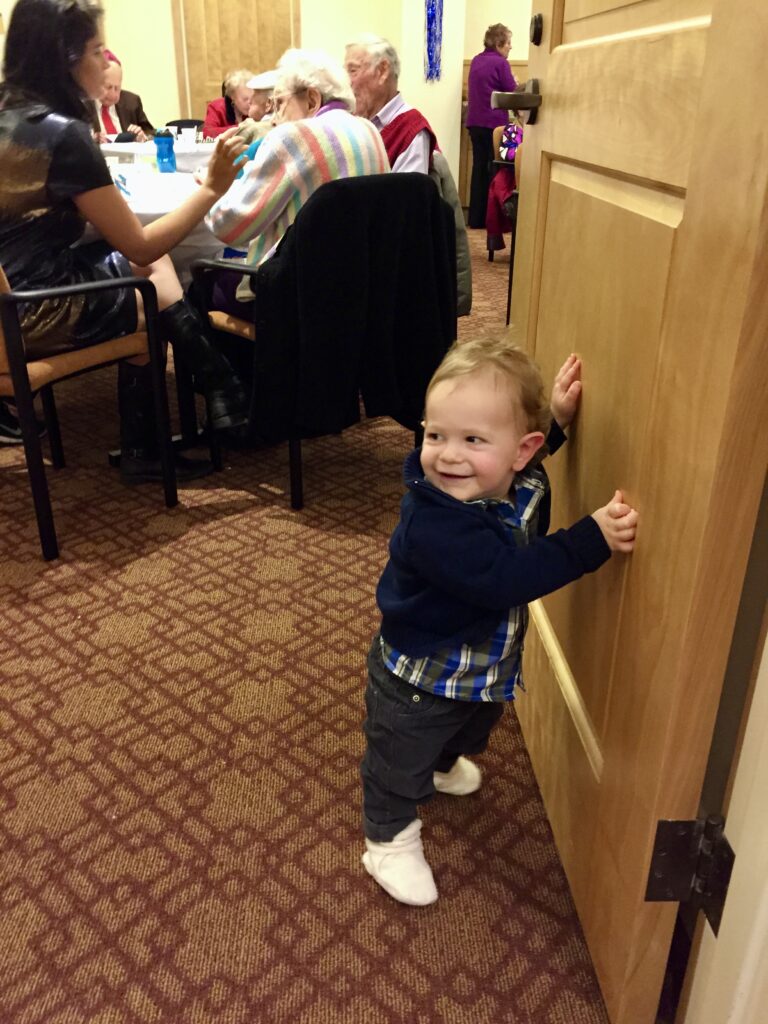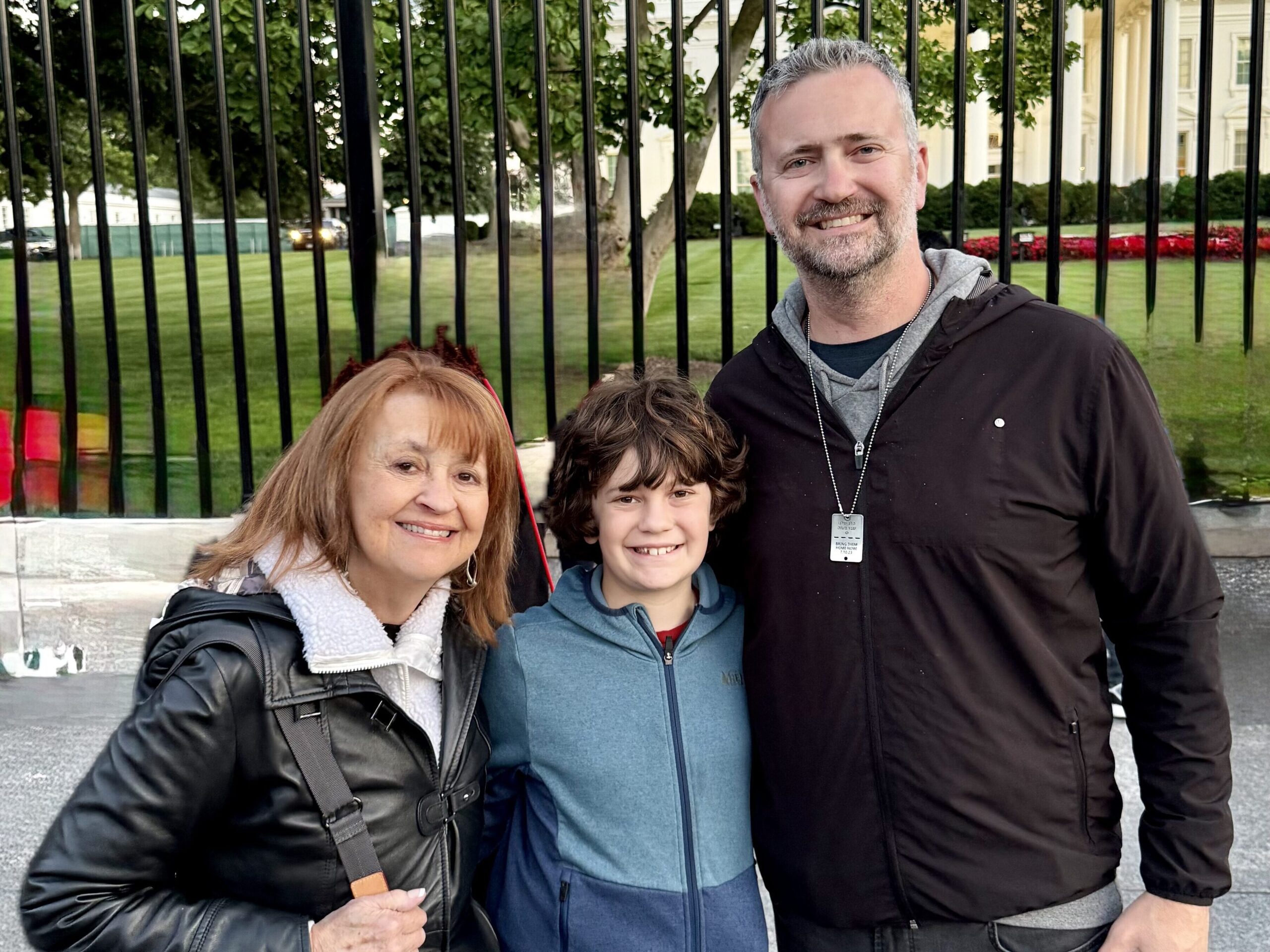When is the Right Time to Teach Kids About the Holocaust?
I Took My 10-Year-Old to the U.S. Holocaust Memorial Museum. Here’s What We Both Learned.
By Steven Green, grandson of Holocaust survivors (3G) and part of the JFCS Holocaust Center’s 3G leadership. His story includes reflections from his son Zev (4G) and his mother Lynette (2G).
My son, Zev Benjamin Green, was born standing on the shoulders of giants. He is a descendant of three extraordinary great-grandparents—Bernard Szabo z”l, a Czech Holocaust survivor who endured Nazi labor camps, Ursula Cohen Green z’’l, a German refugee and one of 10,000 Jewish children saved on the Kindertransport, and Hans Gruenbaum z”l, a WWII liberator of Dachau who escaped Nazi Germany and earned a Bronze Star with the 92nd Signal Battalion. In addition to being named for many of the patriarchs of our family, the Hebrew reversal of his name—Binyamin Ze’ev—echoes the legacy of two towering figures of modern Zionism, Theodor Herzl and Ze’ev Jabotinsky.
It’s no surprise, then, that Zev’s journey into Jewish tradition and historical consciousness began early.
Before he could walk, Zev joined my wife and me at Café By The Bay, a semi-annual gathering of Holocaust survivors hosted by the JFCS Holocaust Center in San Francisco. Though he never met the great-grandparents who survived or fought in the war, Zev connected naturally with Bay Area survivors—through songs, stories, and sufganiyot (jelly donuts). Long before he encountered the brutality of history, he experienced its warmth, its community, and its resilience.

In today’s world, many families try to shield their children from harsh realities. And while this instinct is understandable, experts like Dr. Sivan Zakai—author of My Second Favorite Country: How American Jewish Children Think About Israel—argue that we wait too long to talk about difficult topics. Her research shows that even young children can engage with complexity. They may not grasp every detail, but they can begin to wrestle with justice, identity, and responsibility.
Zev’s exposure to these ideas has only grown. He’s marched against antisemitism and in support of marginalized communities. He’s delivered food packages, run lemonade stands for relief efforts, and internalized the importance of empathy and action.
So when his grandparents planned a 10th birthday trip to Washington, D.C., it felt like a natural next step. But just one day before Zev turned 10, his beloved Opa—my father—passed away suddenly. The trip was put on indefinite hold.
Months later, I tentatively raised the idea with my mother. She was hesitant at first; the trip would be different now. It would be the three of us—three generations: my mother Lynette Szabo Green, Zev, and me. Within days, she embraced the plan.
Logistics came first: a hotel near the monuments—check. Flights aligned from Raleigh and San Francisco—check. Kosher meals coordinated with extended family—check. Then came the itinerary.
My mom had a few must-sees: the Spy Museum, the Smithsonian Air and Space Museum—and, with quiet determination, the U.S. Holocaust Memorial Museum.
I paused. Zev had met survivors, read Alan Gratz novels and I Survived books, and absorbed stories through his Jewish education—but this would be different. I didn’t want to overwhelm or traumatize him. Yet I also didn’t want to deny him the opportunity to bear witness in a thoughtful and supported way.
That’s when we discovered Remember the Children: Daniel’s Story—an exhibit designed for children. It follows the life of a fictional six-year-old boy in Frankfurt, Germany, from 1933 through the war’s end. Visitors walk through Daniel’s home, his room in the Łódź Ghetto, and eventually his experience in Auschwitz. With videos, personal items, and immersive environments, the exhibit offers an age-appropriate but unflinching introduction to the Holocaust. It’s heartbreaking. It’s powerful. And it’s real.

Zev asked thoughtful questions: What was real? How did anyone survive? At other moments, we stood in silence, simply absorbing the weight of the story. I suspect some of his questions will take years to fully unfold.
But the visit was undeniably worth it.
If you’re wondering whether a 10-year-old is ready for such a mature, painful subject, I urge you to consider the alternative. Children will encounter this history eventually—on YouTube, TikTok, or wherever the internet takes them, often without context or care. Better, I believe, to provide a framework rooted in love, tradition, and truth.
Some of the most meaningful education happens outside the classroom. It’s up to us—parents, grandparents, families—to guide the next generation toward understanding. Not just facts, but values. Not just history, but humanity.
Additional Resources for Families and Educators:
Talking to Children About Antisemitism and Hate Crimes
JFCS’ Center for Children and Youth offers practical advice for families on the topics of introducing the Holocaust, addressing antisemitism and hate-based violence. This guide supports caregivers in navigating challenging conversations grounded in love, safety, and truth. Explore the resource ›
Age-Appropriate Guidance from USHMM
The United States Holocaust Memorial Museum offers detailed guidelines for teaching young audiences about the Holocaust, emphasizing developmentally appropriate approaches and reinforcing the importance of context and care. Read the guidelines ›
Daniel’s Story Exhibit
Featured at the USHMM, Remember the Children: Daniel’s Story is a specially designed exhibition for children, aligning with best practices in Holocaust education by presenting difficult history through a child-accessible lens.
JFCS Holocaust Center’s Children’s Bibliography
A curated list of recommended books for children that foster empathy, resilience, and an understanding of Jewish history and the Holocaust. These titles serve as valuable tools for early education on complex topics. View the bibliography ›



